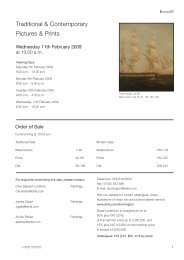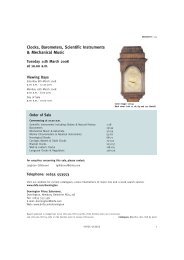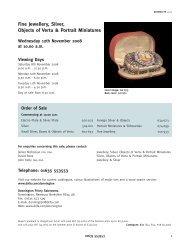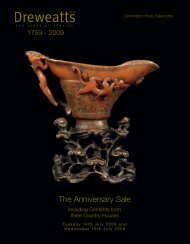Donnington Priory Salerooms
Donnington Priory Salerooms
Donnington Priory Salerooms
You also want an ePaper? Increase the reach of your titles
YUMPU automatically turns print PDFs into web optimized ePapers that Google loves.
42<br />
84<br />
85<br />
84<br />
A Queen Anne walnut longcase clock<br />
Asselin, London, early 18th century<br />
The four-pillar inside countwheel bell-striking movement with 12 inch square<br />
brass dial with calendar aperture, ringed winding holes and subsidiary<br />
seconds dial to the matted centre within an applied silvered Roman<br />
numeral chapter ring with Arabic five minutes, stylised fleur-de-lys half hour<br />
markers and signed Asselin, London to lower edge, the angles with twin<br />
cherub and crown pattern spandrels, in a case with moulded cornice and<br />
foliate fretwork frieze above integral columns to hood door, concave throat<br />
moulding and rectangular quarter veneered door centred by a brass lenticle<br />
to trunk, on a rebuilt plinth base with moulded skirt, 217cm high.<br />
Probably Stephen Asselin who is recorded in Loomes, BrianThe Early<br />
CLOCKMAKERS of Great Britain as working circa 1700-20.<br />
£2,500-3,500<br />
85<br />
A William III eight-day longcase clock movement and dial<br />
John Webster, London, circa 1700<br />
The four (formerly five) finned pillar movement with internal countwheel bell<br />
strike and 12 inch square gilt brass dial with herringbone engraved calendar<br />
aperture, ringed winding holes and subsidiary seconds ring to the matted<br />
centre within an applied silvered Roman numeral chapter ring with Arabic<br />
five minutes to the narrow outer track, stylised sword-hilt half hour markers<br />
and signed John Webster, London to lower edge, the angles applied with<br />
gilt mask and scroll cast spandrels with foliate engraved infill between.<br />
Two clockmakers with the name John Webster are recorded working at the<br />
end of the 17th century, the first was apprenticed to Thomas Tompion in<br />
1676 but apparently not made Free of the Clockmakers Company, the<br />
second was apprenticed to Henry Merryman in 1686, Freed 1695 and was<br />
known to be working into the early 18th century. The current lot has<br />
survived in good original condition retaining its original gilt finish to the dial<br />
plate and escapewheel, the only significant fault being the removal of the<br />
fifth pillar.<br />
£800-1,200<br />
www.dnfa.com/donnington






